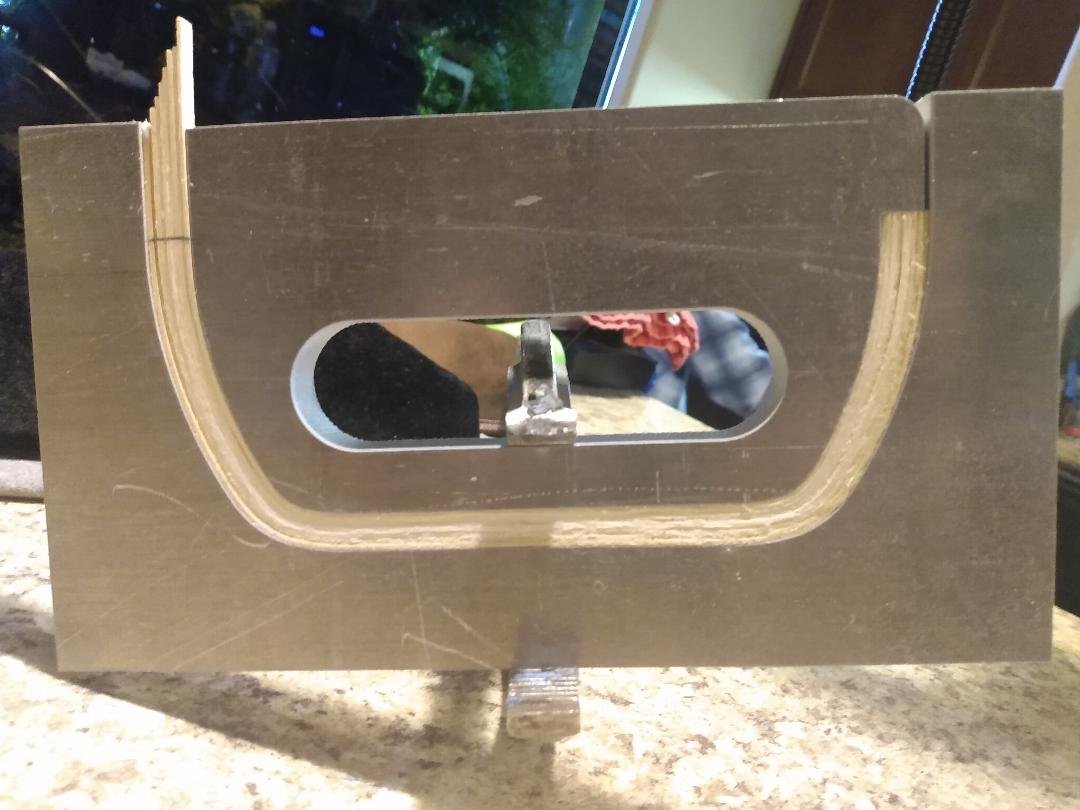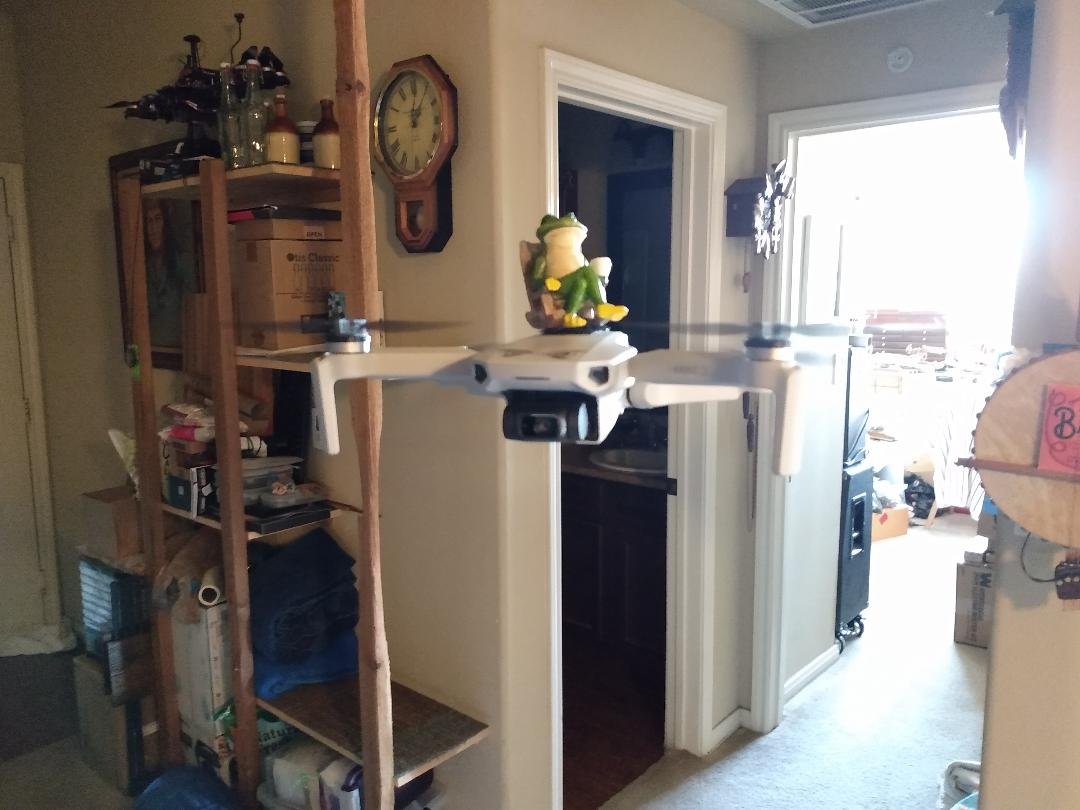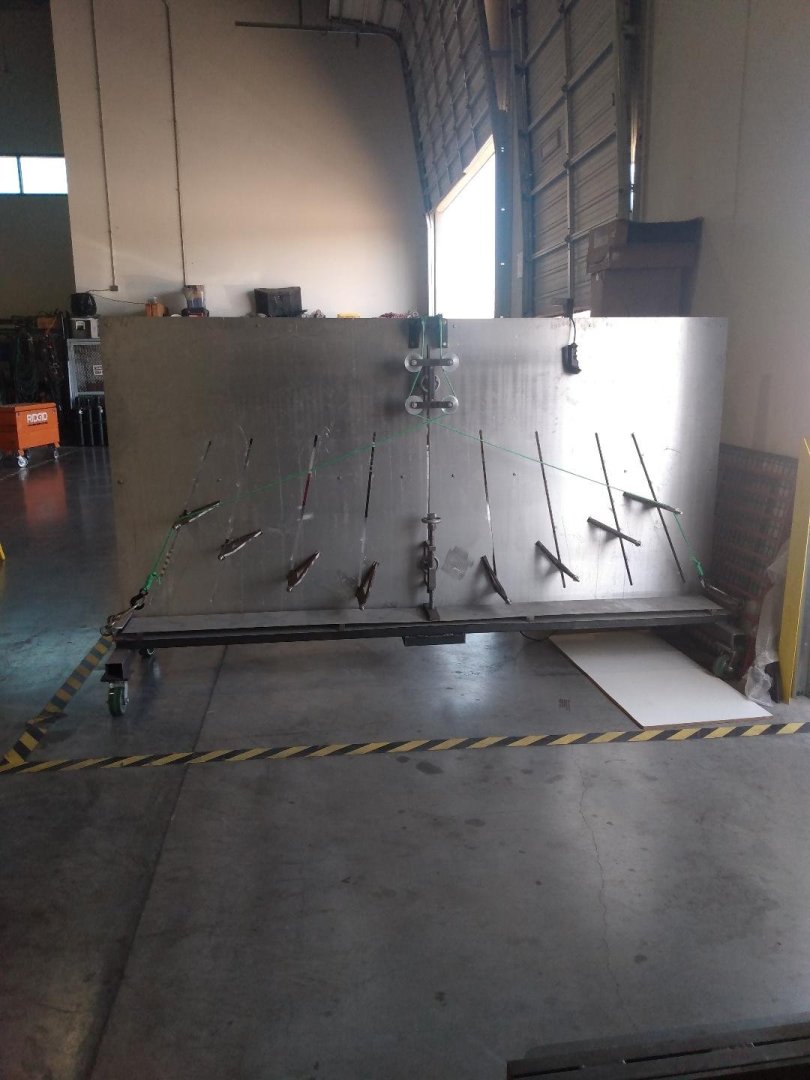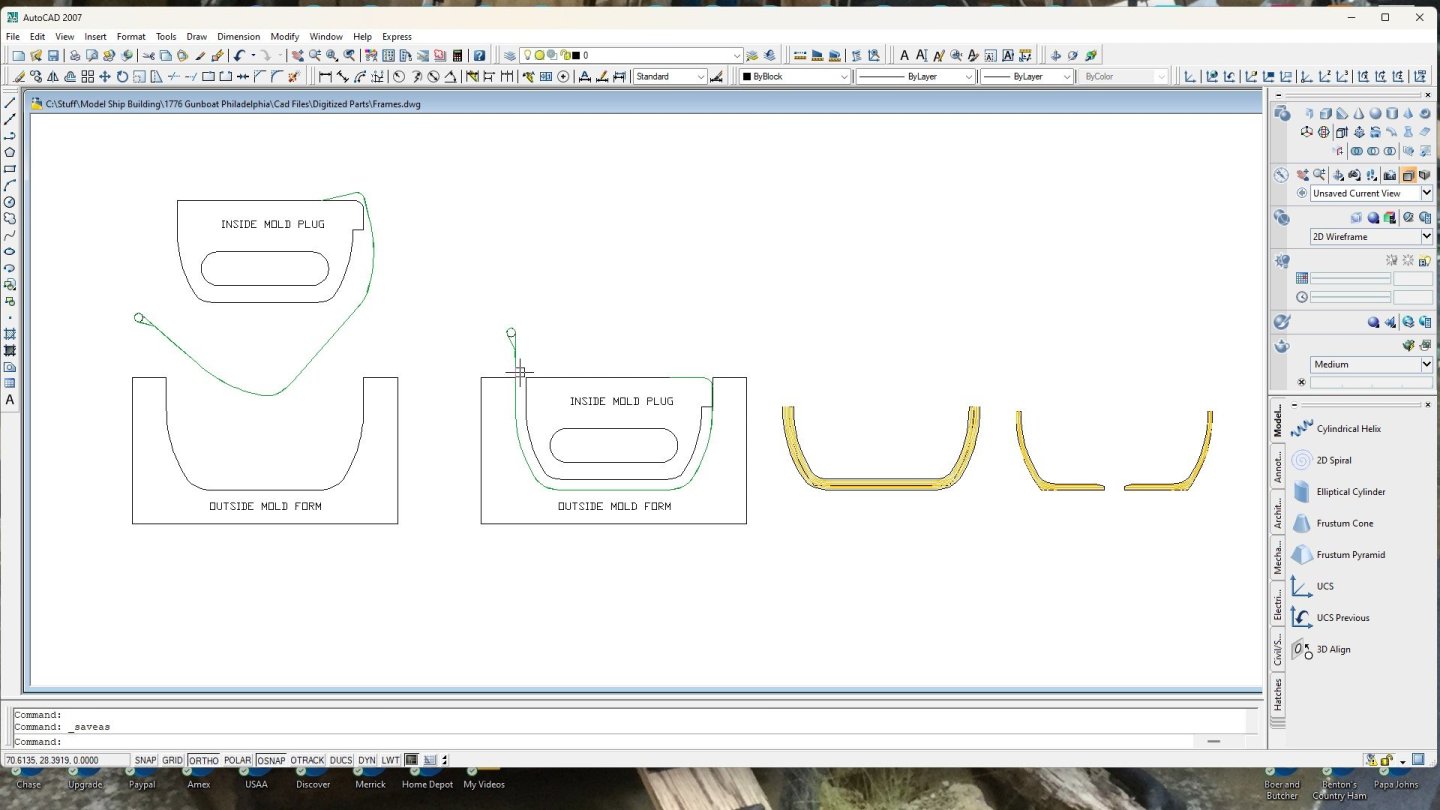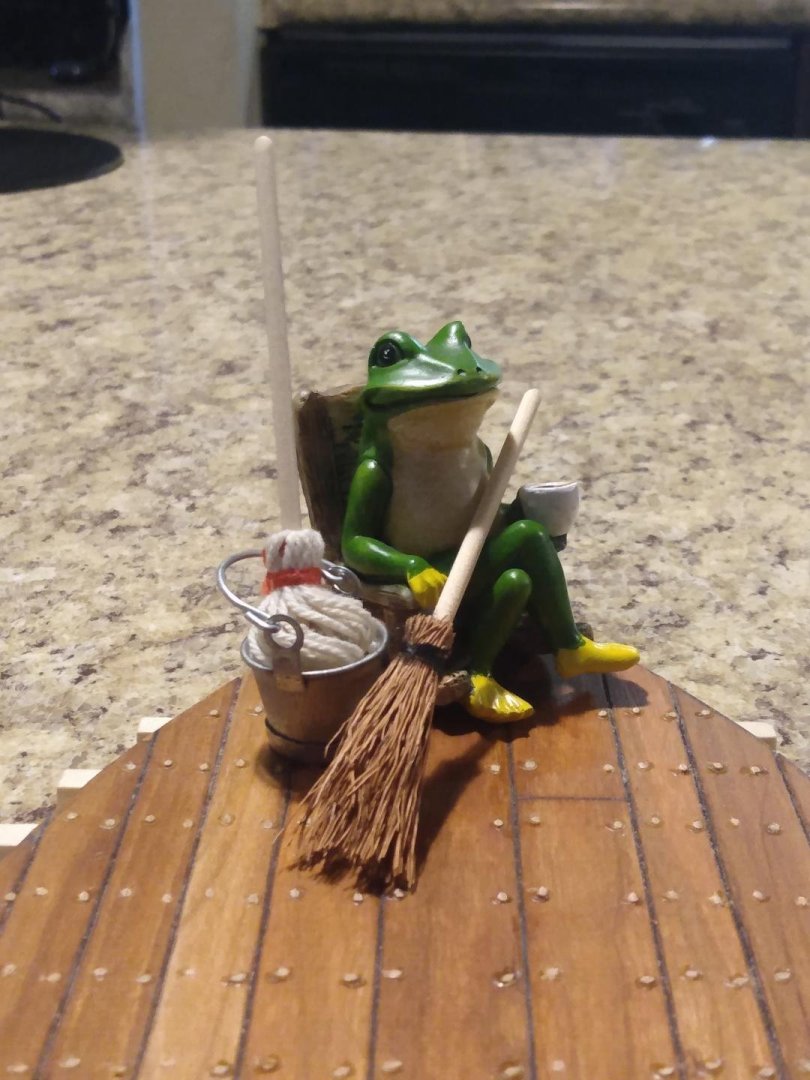-
Posts
725 -
Joined
-
Last visited
Content Type
Profiles
Forums
Gallery
Events
Everything posted by tmj
-

Gunboat Philadelphia 1776 by tmj
tmj replied to tmj's topic in - Build logs for subjects built 1751 - 1800
First set of frames taking shape. There are nine ply's of 1/32" X 3/16" Basswood strips clamped in this mold. No glue, just a test run to see what I'll be up against in bending the wood. So far so good, but I need to modify my mold a little to make it 'less awkward' in loading it with wood strips after glue has been applied to those strips. Each one of these rough moldings will make two frames, one port and one starboard. The frames molded in 'this' fixture will cover stations #13 through #30. The inside geometry of the frames is the actual internal shape. The 'outside' geometry of the frames will be cut to actual shape on the bandsaw. -

Gunboat Philadelphia 1776 by tmj
tmj replied to tmj's topic in - Build logs for subjects built 1751 - 1800
Back atcha, Keith... "Merry Christmas!" -

Gunboat Philadelphia 1776 by tmj
tmj replied to tmj's topic in - Build logs for subjects built 1751 - 1800
-

Gunboat Philadelphia 1776 by tmj
tmj replied to tmj's topic in - Build logs for subjects built 1751 - 1800
Howdy Keith! Yep, all is well. I'm just taking a little break right now trying to learn the ropes of tissue culturing plants and also studying up for an upcoming FAA part 107 certification. I should be getting back to work soon after the holidays. Have you started on 'your' newest project yet? -
Of course it will work! Endeavor to persevere. The more you try, the more you learn, the closer you get to perfection. An old Japanese proverb once said; "Fall seven times, stand up eight!"
- 185 replies
-
- Flying Dutchman
- Black pearl
-
(and 2 more)
Tagged with:
-

Gunboat Philadelphia 1776 by tmj
tmj replied to tmj's topic in - Build logs for subjects built 1751 - 1800
My frame molding fixture was finally cut out today. I just need to have two holes drilled and tapped and the fixture itself will be 95% completed. The only thing left will be to shear the .0035" thick stainless steel backing strap and silver solder a loop into the pulling end of that strap. I'm hoping to get that all done this weekend so I can give 'er a test drive and bend some wood. Sorry for the delays. Home and work priorities have gotten in the way of progress lately, but I'm about to be able to get back on track. Thanks for bearing with me... -
Beautiful Keith!!! If you're having a hard time with 'finally' completing this fantastic build, and still find yourself looking for some other little touches that you could add to it... Hmm. Maybe 'further darkening' the walking path around and into the door showing a lot of foot traffic, dirty boots and abuse in that area as well as any 'other' areas that would get significantly more foot traffic than other areas. Just a thought. 🙂
-

Gunboat Philadelphia 1776 by tmj
tmj replied to tmj's topic in - Build logs for subjects built 1751 - 1800
I'm taking a break from the Philadelphia for a couple weeks or so. I've got a lot of irons in the fire right now and need to complete a few 'other' projects before coming back to this build. Up first is to get all of my tropical Nepenthes pitcher plants set up in indoor grow tents before ol' Man Winter rolls in. They've been on the back porch all summer, which was tough. Too hot and not enough humidity. I had a fancy setup to hopefully keep conditions under control, but it couldn't handle our brutal Texas conditions once the dog days of August set in. The upcoming cold winter will be the "Coupe De Gras" on my already stressed plants. They need to come inside and become permanent fixtures indoors. I've almost got tent #1 ready. I'll be working on this for the rest of today. 1 tent almost ready, two more tents to go... -
Don't make a vase like whirlpool as seen in the video. Just make an inner plug and fill it with bird-shot, or sand so it will hold its shape while being surrounded by wet epoxy resin. When all is said and done, dump out the BB's or sand, pull the mold out and "Viola!" I've seen enough of your work and talent to know for fact that you could indeed pull this off! ☺️
- 185 replies
-
- Flying Dutchman
- Black pearl
-
(and 2 more)
Tagged with:
-
"If only you could come up with a way to pull this off in a bottle!" Maybe after 'polishing-off' a bottle some unique ideas will hit you... hopefully before you hit the floor! !!! I'm thinking... model a silicon mold/plug outside of the bottle then stuff it in, prop it up somehow then 'Carefully' inject the epoxy resin into the bottle and around that plug. Once the resin sets, remove the flexible silicon plug/whirlpool form...??? Maybe that silicone whirlpool plug could be suspended from the top of the bottle using temporary clay and toothpicks, etc. until the epoxy cures. That wouldn't violate any SIB rules, would it?
- 185 replies
-
- Flying Dutchman
- Black pearl
-
(and 2 more)
Tagged with:
-

Gunboat Philadelphia 1776 by tmj
tmj replied to tmj's topic in - Build logs for subjects built 1751 - 1800
Yep, about 2,000 of them in 3 minutes time! Ribbit isn't impressed, nor will he go to work with me for some curious reason. He's now happy to stay home and work on the boat. 😲 -

Gunboat Philadelphia 1776 by tmj
tmj replied to tmj's topic in - Build logs for subjects built 1751 - 1800
I've been neglecting my Philadelphia build this week. Work got in the way. I've been wrapping up the design and fabrication of a proprietary steam bending system for the company I work for. Design and fabrication has been completed. All that's left to do is dial things in with the boiler and steam chamber, create an operator's manual, and have a digital radius calculator designed to account for spring back for any desired radius of the most common materials used in commercial architectural construction applications. The video is a walk around of the boiler and steam chamber. It will allow me to steam wood under pressure, up to 6psi max. The pressure will lessen the time required to steam the wood, kinda like cooking meat in a pressure cooker. This will come in handy when steam bending unusually large sized timbers. If I ever wanted to build a full-sized wooden ship, 'this' is what I would use if steam was involved! 🙂 After steaming, the wood goes into 'this' contraption, sandwiched between two 1/8" thick backing plates to hold a radius between bulkheads while doing the bending. No pre-cut forms required as I'm using adjustable 'bulkheads' to set the desired radiuses required. This is where the radius calculator comes in. Rather than having to draw every desired radius in CAD, to determine exactly where to locate the adjustable bulkheads... let the calculator do it quickly. This gadget is powered by a winch and cables worthy of 12,000 pounds of pulling force. I'll get back to the Philadelphia build after I get this system dialed in and ready to go to work... -
I might have an old WWII Enigma machine buried in my garage somewhere... "Lemme go look!"
- 301 replies
-
- Constitution
- Bluejacket Shipcrafters
-
(and 1 more)
Tagged with:
-

Gunboat Philadelphia 1776 by tmj
tmj replied to tmj's topic in - Build logs for subjects built 1751 - 1800
Here's how I'm going to bend my laminated frames. I'll be making two fixtures, an inner plug and an outer form. The inner plug will have a .003" thick stainless-steel back-strap attached to it. After coating the strips of wood with glue, on one side, using a small paint roller, I'll stack them together and butt one end of the laminated bundle against that step you see on the right side of the inner plug. I'll then pull the stainless backstrap tightly around the wood bundle pulling the wood around the shape of the inner plug. The outer form will then be clamped to the inner plug via that large hole... and stay that way until the glue is fully cured. If this doesn't work, I'll need to use heat. I'm also wondering if there will be any spring back in the shape of the frames after removing them from the mold. I might have to change the shape of the mold to adjust for any spring back. The molds shown below are the actual forms for frames #13 through #30. The only thing that changes with those frames is the length of their horizontal feet. This fixture will accommodate the longest of those feet. This same fixture may also be good for "ALL" of the frames due to the amount of wood that needs to be trimmed away. Not sure about that yet but fingers are crossed... -

Gunboat Philadelphia 1776 by tmj
tmj replied to tmj's topic in - Build logs for subjects built 1751 - 1800
Ribbet hasn't cared much about helping me out with trunnels. No team spirit. He kept going missing and getting drunk leaving all the work to 'ME'! I got fed up with that, so I sent him TAD to the 1st lieutenant division to let him swab decks and clean toilets for a while!
About us
Modelshipworld - Advancing Ship Modeling through Research
SSL Secured
Your security is important for us so this Website is SSL-Secured
NRG Mailing Address
Nautical Research Guild
237 South Lincoln Street
Westmont IL, 60559-1917
Model Ship World ® and the MSW logo are Registered Trademarks, and belong to the Nautical Research Guild (United States Patent and Trademark Office: No. 6,929,264 & No. 6,929,274, registered Dec. 20, 2022)
Helpful Links
About the NRG
If you enjoy building ship models that are historically accurate as well as beautiful, then The Nautical Research Guild (NRG) is just right for you.
The Guild is a non-profit educational organization whose mission is to “Advance Ship Modeling Through Research”. We provide support to our members in their efforts to raise the quality of their model ships.
The Nautical Research Guild has published our world-renowned quarterly magazine, The Nautical Research Journal, since 1955. The pages of the Journal are full of articles by accomplished ship modelers who show you how they create those exquisite details on their models, and by maritime historians who show you the correct details to build. The Journal is available in both print and digital editions. Go to the NRG web site (www.thenrg.org) to download a complimentary digital copy of the Journal. The NRG also publishes plan sets, books and compilations of back issues of the Journal and the former Ships in Scale and Model Ship Builder magazines.


